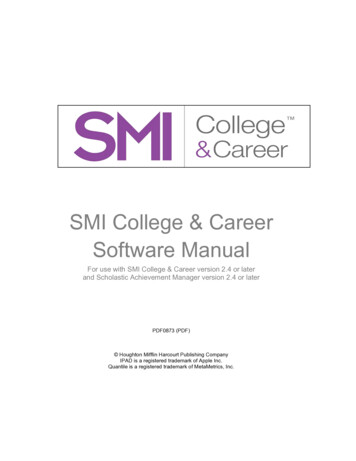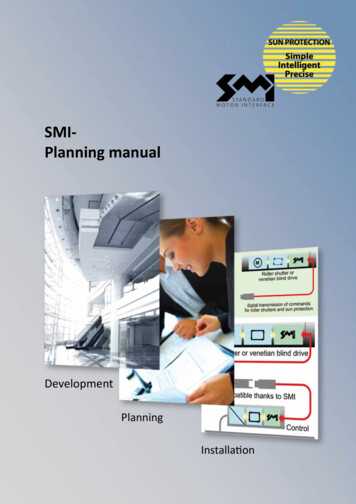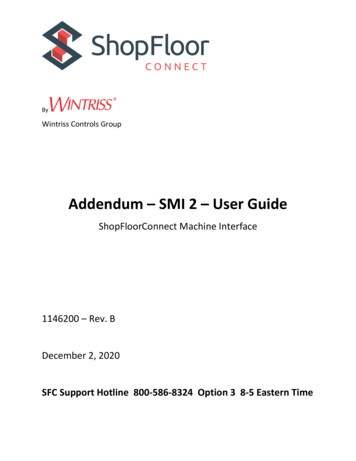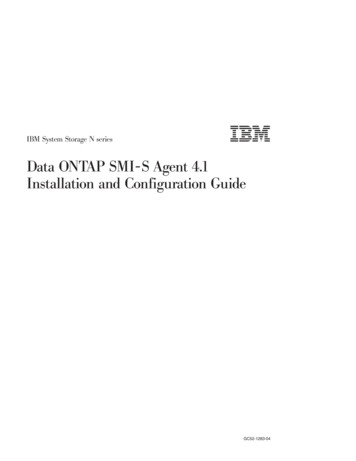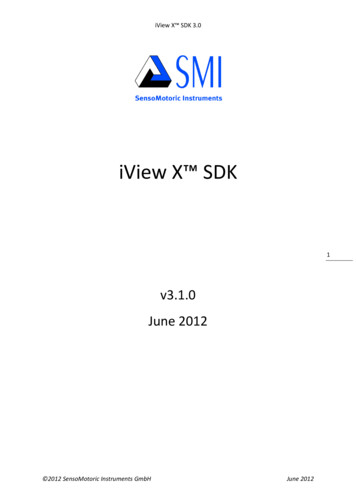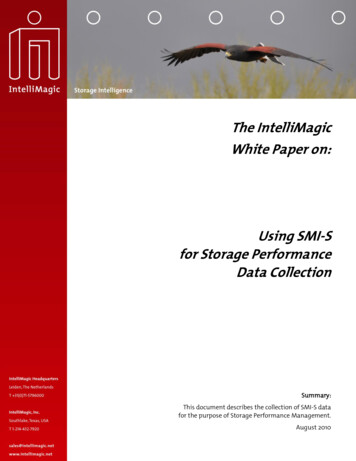
Transcription
The IntelliMagicWhite Paper on:Using SMI-Sfor Storage PerformanceData CollectionSummary:This document describes the collection of SMI-S datafor the purpose of Storage Performance Management.August 2010 IntelliMagic 2010Page 1
This reference guide was prepared by:IntelliMagic BVLeiden, The NetherlandsPhone: 31 71 579 6000IntelliMagic IncSouthlake, Texas USAPhone: 1 214 432 7920Email: info@intellimagic.netWeb: www.intellimagic.netDisclaimerThis document discusses SMI-S data collection.IntelliMagic products can be used to support all phases of Storage Performance Managementprocesses. Appropriate usage and interpretation of the results of IntelliMagic products are theresponsibility of the user.SupportPlease direct support requests to support@intellimagic.netPlease direct requests for general information to info@intellimagic.net.TrademarksAll trademarks and registered trademarks are the property of their respective owners. 2010 IntelliMagic BV IntelliMagic 2010Page 2
Table of ContentsChapter 1 Overview. 4Chapter 2 Data Collection Approaches . 5Chapter 3 What is SMI-S? . 6Chapter 4 How does SMI-S work? . 7Chapter 5 What type of data can be collected with SMI-S? . 8Performance Data . 8Configuration Data . 9Chapter 6 What are the SMI-S Provider configuration requirement . 116.1 Key Documents . 116.2 Required Software . 126.3 Key Configuration Variables . 12Network Ports . 12Security and Privileges . 13Collection Intervals . 13Chapter 7 Conclusion.14 IntelliMagic 2010Page 3
Chapter 1 OverviewTo easily improve storage service levels and cost efficiency, most sites would like to use anintegrated solution for managing storage performance. Except for rare cases, there is no longer asignificant technical barrier preventing the adoption of a best of breed storage performancemanagement solution such as the IntelliMagic Suite.The reason for this new flexibility is the market acceptance and maturity of the vendor neutralStorage Management Initiative Specification (SMI-S). Initially released in 2002, SMI-S has beenthrough several iterations, and now, eight years later, is on the 4th generation of the specification.Storage giants such as EMC, IBM, and Hitachi have all been key sponsors of the efforts in additionto other well known companies including 3PAR, NetApp, LSI, Quest Software, Symantec, andFujitsu.The need for cross-vendor management tools has driven the adoption of this specification. Initialadoption of the specification by hardware vendors was lukewarm and implementations wereimmature. Fortunately for users, many of the hardware vendors are now very supportive of theSMI-S standards. Based on the current trend, it is likely that most new storage hardwareplatforms will include native SMI-S support.This paper examines the fundamentals of SMI-S including the following topics:Chapter 2:Chapter 3:Chapter 4:Chapter 5:Chapter 6:Chapter 7:Data collection approachesWhat is SMI-S?How does SMI-S work?What type of data does SMI-S Collect?What are the basic requirements for configuring an SMI-S provider?ConclusionThe intended audience of this paper includes storage administrators, storage architects, andstorage managers who are looking to gain a high level understanding of SMI-S. Figure 1: BasicSMI-S Collection, provides a high level example of the SMI-S data collection flow.Figure 1: Basic SMI-S Collection IntelliMagic 2010Page 4
Chapter 2 Data Collection ApproachesIn order to obtain storage performance and configuration data, tool vendors have, until recently,relied on platform specific APIs. While there are some definite advantages to this approach, thereare also some drawbacks.With SMI-S support becoming pervasive, it is now viable and strategic to consider SMI-S as analternative for implementing storage management solutions. This chapter discusses the pros andthe cons of each approach as illustrated in Table 1: Vendor Proprietary Versus Vendor Neutral.Table 1: Vendor Proprietary Versus Vendor NeutralFeatureVendor SpecificSMI-S (Vendor Neutral)Communication betweenVendor proprietary fast protocolStandard XML basedmanagement tool and storagecommunication for all exchangesdeviceSupport for platform specificNo distinction between standardProtocol requires minimummetricsand platform specific metricsnumber of fields and supportsvendor extensions for extra fieldsand components.Compatibility with otherSpecific to one hardwareAny SMI-S supporting hardwarehardwareplatform onlyThird party accessFew documented interfaces,Open specification to any tooldifferent interfaces for eachvendorplatformInitial Hardware ProvisioningDesigned for specific hardwareDifficult to support with SMI-SSupportdue to hardware specificimplementations.There are several benefits of using proprietary solutions, including speed and the rich metricsprovided. Conversely, there are some drawbacks, including inflexibility, maintenance challenges,expensive vendor specific licensing, and the tendency to be reliant on a hardware vendor formanagement solutions.Vendor neutral solutions on the other hand, such as SMI-S, provide standard managementinterfaces and lower the barriers of entry for software vendors wishing to enter the storagemanagement market. This is an advantage for users, who will benefit from competition in themarket place.One challenge associated with using a standard, is the necessary reliance on commoncommunication models which are often slower. Another challenge is that certification forcompliance utilizes a lowest common denominator approach. This means that the minimumrequirements for compliance are set at a very low bar. Fortunately, all major vendors haveimplemented extensions of the SMI-S standard to report the additional metrics that areimportant for their hardware. IntelliMagic 2010Page 5
Chapter 3 What is SMI-S?Storage Management Interface Specification, SMI-S, was created by the Storage NetworkingIndustry Association (SNIA) in conjunction with the Distributed Management Task Force (DMTF)to develop and standardize interoperable storage management technologies.SMI-S is a common, standards-based management specification that permits third partyapplications the ability to configure and manage a storage array. Using the “provider” (the actualsoftware library), a management application doesn’t require knowledge of the specificarchitecture or infrastructure requirements of the particular storage platform.In the SMI-S architecture, client applications communicate with Storage Management InterfaceSpecification (SMI-S) providers, or Common Information Model (CIM) agents, to obtainperformance and configuration information from storage area networking components such assystems, fabric, and host elements.SMI-S providers can report about asset, alerts, and performance information, as well as facilitatestorage provisioning activities. SMI-S also provides reporting for switch and tape libraries. Eachvendor provides a unique provider that facilitates SMI-S based reporting and management fortheir device.SMI-S providers can be implemented either as proxies to the devices or as embedded softwarewithin the actual storage platform. Most legacy storage platforms have implemented their SMI-Sproviders as proxies. The proxies are software libraries external from the storage platforms thataccept SMI-S queries and commands, and translate them into vendor specific commands whichthey send to the storage platforms.As the name implies, the embedded SMI-S providers are included on the storage platforms and donot require the installation or maintenance of a separate software package to provide an SMI-Sinterface to the storage platform. The trend for the newer platforms is to embed the SMI-Sproviders within the storage system as evidenced by the latest IBM DS8000 platforms and theEMC V-Max platforms.For more information on SMI-S, please refer to the following URL:http://www.snia.org/tech activities/standards/curr standards/smi IntelliMagic 2010Page 6
Chapter 4 How does SMI-S work?SMI-S uses standard XML based communication methods to facilitate exchanges between theclient application, the SMI-S provider, and the storage device.Figure 2: SMI-S Communications illustrateshow an SMI-S client communicates with aCIM Server in an EMC environment.1.The SMI-S client sends managementrequests to the CIM server. In an EMCenvironment, the CIM Server and theSMI-S provider components are bothincluded in the EMC SMI-S Provider 4.1.2. The CIM Server receives thesemanagement requests from the clientand communicates with the SMI-Sprovider.EMC’s implementation is a perfect exampleof this transparency. To a storageadministrator you just need to know thatyou are installing the SMI-S Provider, whichincludes both the CIMOM Server and theSMI-S provider. These complexities willlikely become more transparent over time.Figure 2: SMI-S Communications3. In turn the provider communicates withthe storage device using nativecommands. The provider translates theCIM-XML protocol originating from theCIM Client/CIM Server into commandsunderstood by the storage platform.Upon the completion of a command (4),a confirmation message is returned tothe provider (5), then to the server (6),and finally to the client (7).In most implementations there is no need tobe aware of the CIM Server layer. It is almostalways packaged with the vendor’s providersoftware, and is often referred to as a part ofthe collective provider rather than a distinctlayer. IntelliMagic 2010Page 7
Chapter 5 What type of data can be collected with SMI-S?In addition to management functions, SMI-S enables the collection of both performance andconfiguration data. This chapter discusses the type of data that can be collected and reported onusing SMI-S.Performance DataSMI-S uses a template of sorts, called the Block Server Performance Profile (BSP), to define theperformance metrics that providers can make available to a management application. Thestandard template only requires storage subsystem level metrics. Additional components can beaccommodated through vendor specific extensions.The metrics described are: Block Server (Top level Computer System), I/O Ports (e.g., FCPorts) Front-end Ports and Back-end Ports Individual Controllers, Front-end and Back-end controller(s) Volumes or Logical Disks Extents with association to Pools Disk DrivesThe metrics defined in the Block Server Performance Profile (BSP) provide much more detailedinformation about the storage systems than what is available from native distributed platformtools (e.g., iostat, vmstat, sar), but they do not provide performance information from a serverperspective.Due primarily to component differences between the platforms, not all vendors provide thecomplete set of metrics defined by the BSP. At a storage system level, the metrics in Table 2: BSPMetrics are those metrics required for all platforms.Table 2: BSP MetricsRequired MetricsTotal I/OsKbytes transferredRead I/OsRead hit I/OsWrite I/OsWrite hit I/OsDefinitionTotal of Read I/Os and Write I/OsTotal amount of data transferred in KbytesTotal number of Read I/OsTotal number of Read I/Os satisfied by CacheTotal number of Write I/OsTotal number of Write I/Os satisfied by hputCacheAdditional metrics that are commonly available are noted in Table 3: Commonly ProvidedOptional Metrics. IntelliMagic 2010Page 8
Table 3: Commonly Provided Optional MetricsRequired MetricsService TimeTransfer SizeDefinitionRefers to the amount of time required toservice I/O requests. Sometimes this isprovided for both read and writes.Average transfer size in Kbytes.TypeDurationThroughputTable 4: Vendor Component Support shows the optional metric categories that some vendorsprovide.Table 4: Vendor Component SupportComponentStorage systemFront-end AdapterPeer-to-peerBack-end AdapterFront-end PortsBack-end PortsVolumeStorage Pool/RankDisk DriveArbitrary LURemote mirroringIBMEMCDS8000 DS4000 Symm/DMX CX Configuration DataIn order to provide meaningful context for analysis, SMI-S provides configuration informationthat shows the relationships between the different logical and physical storage systemcomponents. These relationships include, but are not limited to, the relationship between thevolumes and the back-end disk devices.These relationships are critical during the analysis stage particularly as some metrics for higherlevel constructs (i.e., RAID Group or Extent Pool) are not available from all hardware platforms. Byusing the relationships between the higher level logical construct and the lower level logicalconstructs (i.e., Logical Volumes), metrics can be estimated for the higher level logical constructsby aggregating statistics from the lower level constructs. While this technique is imperfect, itprovides a reasonable method for “filling in the gaps” and illustrates the criticality of theconfiguration data. IntelliMagic 2010Page 9
Logical Component DefinitionsEach hardware platform has one or more of the following entities that need to be understoodand related to the underlying physical components.Extent: An extent consists of a collection of physical blocks. The extents are grouped togetherand assigned to an Extent Pool. In some platforms, extents are transparent in the sense youcannot configure them directly. Extent sizes vary depending on the platform.Storage Pools: These are groupings of Extents from a set of RAID Parity Groups. These aresometimes referred to as extent pools.Logical Volume: They refer to a specific grouping of extents from a single extent pool, or in caseswhere extent pooling is not employed, they consist of physical blocks located on one or morephysical drives or RAID Parity Groups. They can be “provisioned” directly to hosts or indirectly aspart of a larger Logical Volume Set.Logical Volume Set: On some storage platforms multiple logical volumes can be coalesced tocreate a larger volume. These volumes are provided as a discrete unit to the host who sees theLogical Volume Set as a single entity (for example as one LUN). On the back-end disks, the logicalvolumes can be concatenated or striped to create the larger Logical Volume Set.RAID Parity Group: A Raid Parity Group is a grouping of RAID formatted physical devices.The purpose of the configuration details is to describe the relationships between one logicalentity and other logical entities or other physical entities such as: Which Physical Drives make up a Raid Parity Group? Which RAID Parity Group is part of a particular Extent Pool? Which Logical Volumes are defined on which Extent Pools? Which Logical Volume is part of a Logical Volume Set?These relationships are often many layers deep and quite complex, but necessary in order toaccurately monitor and identify the root causes of performance constraints. Figure 3: CLARiiONStorage Array Configuration illustrates the complexity of the relationships for a fairly simpleCLARiiON storage array. In the case of the CLARiiON platform, a RAID Group consists of two ormore RAID-formatted physical disks. From the RAID Group, logical volumes are formed andprovisioned to the hosts.Figure 3: CLARiiON Storage Array ConfigurationFront-endLUNRAID Group IntelliMagic 2010HDDPage 10
Chapter 6 What are the SMI-S Provider configurationrequirements?The purpose of this chapter is to illustrate some of the key SMI-S provider configuration options,and to provide references to storage vendor specific documentation.In order for any SMI-S client to collect data from your storage systems, an SMI-S provider must beconfigured for each storage system that you want to collect data from. Each of the storagevendors supporting SMI-S furnishes installation guides and instructions for their SMI-S provider.As a general rule the configuration of the SMI-S provider consists of the following key steps:1.Install the required storage vendor SMI-S provider software2. Discover and confirm connectivity and authorization between the provider software andthe end devices (e.g., Storage system).URLs for vendor specific documentation can be found in Table 5: Vendor Documentation Matrix.These references provide a starting point for finding the vendor specific documentation:Storage PlatformsTable 5: Vendor Documentation MatrixDocumentation hp.com/support/manualsIBM DS8000/DS6000/ESSIBM docview.wss?rs 0&uid ssg1S4000557http://www.engenio.com/products/smi provider re.pdfNote: Hardware vendor URLs change frequently. If the URLs in Table 5: Vendor DocumentationMatrix do not work, then try going to the parent URLs and searching for the storage platformand SMI-S, SMIS or CIM agent.6.1 Key DocumentsEach vendor provides documentation for the installation of their SMI-S providers. We have foundthe documents specified in Table 6: Key Vendor Documents to be helpful in guiding theinstallation of the SMI-S providers.Storage PlatformsEMCHPHitachiIBM DS8000/DS6000/ESS IntelliMagic 2010Table 6: Key Vendor DocumentsDocument Name/ReferenceEMC SMI-S Provider Version X.X Release NotesHP StorageWorks Command View XPHitachi Storage Command Suite Hitachi Device Manager SoftwareSMI-S Provider Installation and User GuideIBM TotalStorage Productivity Center: The Next GenerationPage 11
IBM DS3000/DS4000/DS5000Table 6: Key Vendor DocumentsLSI SMI-S Provider Installation Guide for Version XX.xx.XXMost of these documents can be found by searching the vendors’ web sites displayed in Table 5:Vendor Documentation Matrix.6.2 Required SoftwareEach of the SMI-S providers has its own required software depending on the storage platform.Table 7: SMI-S Providers and Storage Platforms demonstrates the necessary provider software foreach of the storage platforms listed. Additional pre-requisites may be required depending on thevendor and platform.Table 7: SMI-S Providers and Storage PlatformsStorage PlatformProvider SoftwareEMC CLARiiONCLARiiON Navisphere Release 19, 22, 24, 26, 28, 29 &EMC Solutions Enabler V7.1.0 or laterEMC Symmetrix, and VMAXEnginuity version 5668 or higher &EMC Solutions Enabler V7.1.0 or laterHP XP 24000HP StorageWorks XP Command View AE CLI SMI-SHitachi USP-VDevice Manager & Device Manager agent 6.3 orlaterIBM DS8000CIM Agent for DS OpenIBM DS3000/DS4000/DS5000SMI-S Provider (new) Version 10.10.GG.35 or later.6.3 Key Configuration VariablesThere are several common configuration variables that one should be aware of when configuringSMI-S providers. This section attempts to identify the key configuration variables and theirdefault values.Network PortsThe SMI-S Provider listens for requests from an SMI-S client like the IntelliMagic Vision for SMI-Scollector on a default set of network ports. By default, the ports are 5988 for http and 5989 forhttps. These ports can be changed in the case where there is a conflict with some other servicerunning on the same server. Consult the vendor specific documentation for instructions onmodifying ports.The SMI-S provider or CIM agent may require ports for communication with the storage devices.The ports required for this communication are in addition to the ports used by the CIM agent toSMI-S provider communication. Consult vendor specific documentation for determining theproper ports for the SMI-S provider to end device communications. IntelliMagic 2010Page 12
Security and PrivilegesWhen configuring an SMI-S provider, it is important to understand the required user ids andtheir associated access privileges. In order to configure a provider to communicate with astorage device, a valid user ID and password must exist. Table 8: User IDs describes user IDinformation for known providers.Table 8: User IDsPlatformEMC CLARiiONHP XPProvider SoftwareCLARiiON NavisphereEMC Solutions Enabler with SMI-SProviderEnginuity version 5668 or higher &EMC Solutions Enabler with SMI-SProviderHP Command View XPHitachiDevice ManagerIBM DS8000/DS6000CIM Agent for DS Open (Embeddedin R4.1 FW. Prior to R4.1 resides onHMC)DSCIMCLISMI-S Provider (new)EMC Symmetrix, DMX andVMAXIBMDS3000/DS4000/DS5000Required Userids/GroupsID used by NaviCLI to log onto CLARiiONID to access array, MonitorID can be used.AdministratorUserid/Password for deviceView access to each storagesystemAdministratorUserid/Password for device(Prior to R4.1 neededadditional userid on HMC)Defaults to authenticationturned off, but can beenabled.Collection IntervalsSMI-S provides an interval mechanism for data collection such that statistics can be queried atany point during the next interval. This allows agents to query information once every interval(3-60 minutes). The SMI-S standard does not allow true real-time collection. The ability toconfigure the provider collection interval will vary from platform to platform. IntelliMagic 2010Page 13
Chapter 7 ConclusionStorage Performance Management (SPM) is growing in importance as data center managers seekto improve storage hardware efficiency and service levels. Mature SPM processes start with thecollection of the right performance metrics.SMI-S provides a robust, vendor neutral standard for collecting storage performance andconfiguration data. As the SMI-S standard continues to mature, and hardware vendors furtherintegrate SMI-S support into their platforms, more management tools will utilize SMI-S data.The reduced effort required to collect storage performance data will allow managementsoftware vendors to spend more effort innovating their products and solutions. No longer willcollecting the data and providing generic charts be sufficient.The innovations will likely take the form of advanced analytical capabilities with vendor specificanalysis of performance and configuration metrics. Best of breed products are differentiated forexample, by providing views of the data that quickly and easily identify performance andconfiguration issues at early stages, often before end-users ever experience degradation.Customers will expect qualitative analysis of the performance of their hardware investments.IntelliMagic seeks to provide the highest quality Storage Performance Suite on the marketthrough comprehensive data collection and sophisticated analysis that enable data centers toeasily progress from re-active SPM processes to more efficient, effective, and lower cost proactive and predictive processes.To learn how IntelliMagic can help you achieve your specific storage performance objectives,please contact sales@intellimagic.net. IntelliMagic 2010Page 14
storage provisioning activities. SMI-S also provides reporting for switch and tape libraries. Each vendor provides a unique provider that facilitates SMI-S based reporting and management for their device. SMI-S providers can be implemented either as proxies to the devices or as embedded software within the actual storage platform.
